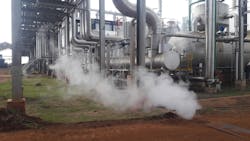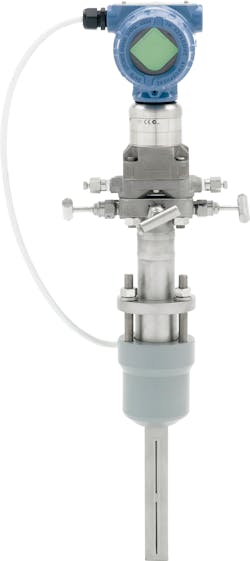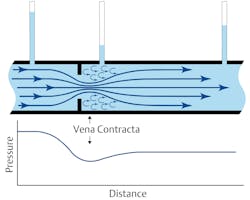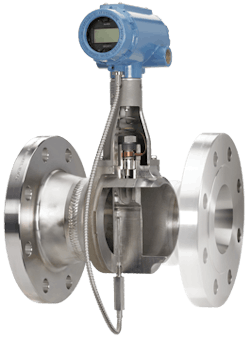Improving efficiency and effectiveness with advanced steam measuring capabilities
Steam is utilized in all types of manufacturing processes in nearly every industry, from pulp and paper mills and food production to chemical plants and pharmaceuticals. It delivers energy in easily controllable quantities, making it useful for a large variety of applications. It is also one of the most versatile ways to transfer heat energy throughout a system, yet many facilities depend on this vital component without the instrumentation necessary to manage it efficiently and effectively.
Typically, plant operations rely on older installations and legacy equipment to monitor steam flow, resulting in insufficient insight into the process. In many cases, this forces prioritization of process control over energy efficiency and optimization. But today, steam measuring capabilities have advanced so that, with the right instrumentation, manufacturers can leverage deeper knowledge of their steam generation and delivery processes for significant energy and cost savings.
With steam, simple volume measurements are not enough to provide true visibility into energy usage. Pressure and temperature data are crucial for understanding the amount of energy contained in the volume of steam, so differential pressure (DP) and vortex flow meters that can capture this data are the best technologies to employ. These easy-to-install DP and vortex flow meters have integrated temperature and pressure sensors, and they can be deployed at critical junctures throughout a plant to provide process engineers with a greater understanding of what is happening at a granular level. This increased monitoring helps to identify leaks and suggest opportunities for enhanced energy-saving strategies. By choosing the right technologies based on operational conditions, facilities can maximize control and productivity and minimize energy loss in steam distribution systems.
The high costs of inefficiencies in steam production, consumption and measurement
A significant portion of energy expenditure in process manufacturing facilities is spent generating steam. In fact, steam production can account for up to 40% to 50% of a plant’s entire energy budget. Steam is expensive to generate, and as energy prices rise, manufacturers need better ways to accurately measure and control steam inputs in their processes to optimize these systems and save on costs.
In industrial processes, energy from steam is consumed as it is carried along its distribution system from a centralized boiler or boiler system to perform a variety of tasks like driving turbines to produce electricity, breaking down heavy hydrocarbons into a lighter hydrocarbon feedstock via ethylene crackers, performing sterilization and providing enhanced mixing and tip cooling for flares. Each of these applications has specific flow, temperature and pressure requirements. In the absence of consumption data with enhanced pressure and temperature analysis, process engineers cannot effectively balance energy demand throughout the distribution system. Plant productivity suffers. Energy losses due to poor insulation, stuck or leaking steam traps, and steam leaks are more difficult to discover and pinpoint for correction.
From a measurement perspective, older methods of capturing steam flow data can also introduce inefficiencies. Flow errors occur due to changing conditions, making them less accurate as well. Traditional DP flow meter technologies utilize orifice plates that require piping to a transmitter. The setup results in pressure loss through the measurement point and many additional connection points that can leak and cause problems. The pressure loss might not seem significant, but losing even two to three psi of pressure can quickly add up to thousands of dollars in energy waste per device per year. Not only does this style of installation increase fuel costs, but complex installs and ongoing maintenance of so much equipment significantly increases labor costs over time.
Why it is challenging to measure steam flow accurately
Accurate and reliable flow measurement is key to proactively limiting and reducing inefficiencies in steam systems, but steam’s many forms can complicate flow rate calculations. Predominately, the technologies used to capture steam flow only measure velocity, converting it to a volume measurement with a mass flow calculator. Unfortunately, without factoring in changing conditions and fluctuating temperatures and pressures, errors in mass output frequently occur.
Because steam can be wet or dry, saturated or superheated, and is present at a wide range of temperatures and pressures, standard flow meters require additional devices to collect temperature and pressure measurements and convert all the data to a mass flow output. Then, these older installations also require a different flow computer to calculate energy content by working enthalpy into the equation, which determines the energy rate in kJ/kg or Btu/lb. Modern flow meters designed with steam applications in mind will provide the energy rate as a direct output, eliminating the need for so many additional devices in the field.
Saturated steam with liquid content (i.e., wet steam) introduces the added difficulty of plugging and wear and tear on devices caused by solids and other impurities in the flow. This often means facilities must deploy test separators or throttling calorimeters to properly quantify the steam's liquid content. Steam used for power generation, turbines and drying (i.e., superheated steam) is saturated steam heated beyond its boiling point until all moisture is gone. Utilizing this resource calls for separate temperature and pressure sensors, as they can change independently of one another.
Velocity-based flow meters do not have a method to compensate for changes in the density (energy) of steam on their own, so discrete pressure and temperature devices are necessary. Multivariable flow meters with built-in temperature and pressure sensors and a direct output of energy rates are the best technologies for measuring steam flow.
Measuring and monitoring steam flow in process applications with the latest technology
Clearly, an all-in-one solution would be highly advantageous, especially in process industries. Fortunately, today’s differential pressure and vortex flow metering technologies are extremely effective at capturing consistently accurate flow data in steam applications.
Updated differential pressure flow metering devices
Differential pressure flow meters operate by measuring a pressure change caused by a restriction in the line. Advanced DP technology allows for the use of a conditioning orifice, to minimize the need for straight pipe ahead of the installation, or an Annubar averaging pitot tube to significantly reduce permanent pressure loss at the measurement point. The DP transmitter reads the pressure signal and converts it to an electronic signal for the control system. This data is used to calculate fluid velocity and volumetric flow. In steam applications, integrated pressure and temperature sensors take precise readings for direct conversion to mass flow rates.
One concern with DP flow meters is how measurements can be negatively affected by upstream flow disturbances. They usually need to be installed in relatively long straight and smooth pipe sections upstream and downstream from the primary element for the most accurate readings. However, modern DP flow meter designs are far more versatile than in the past when they relied upon traditional orifice plates. New options have upgraded orifice plates with four holes instead of one, helping to alleviate measurement challenges and allowing much shorter straight pipe requirements — all while ensuring higher measurement accuracy and repeatability.
Leading-edge Annubar flow meter designs generate the lowest pressure drop, resulting in significant energy savings over the life of the instrument. They are particularly well-suited to large (>8 inches or 200mm) line sizes because they are an insertion-style meter.
Another key feature of DP flow meters is that they can operate totally wireless with power provided by an onboard battery and measurements transmitted via WirelessHART. This allows measurements to be added where they may have been cost prohibitive in the past, and operators gain a more granular view of energy usage.
Typically, the drawbacks of DP technology lie in two areas: impulse lines prone to clogging and the many components involved in a DP flow installation. To combat these issues, advanced DP flow meters are designed as a single assembled unit — eliminating the need for impulse lines and making installation simple and easy. Multivariable transmitters add performance capabilities like remote connectivity, increased turndown and low-flow measurement, and real-time flow compensation for changing densities and flow conditions.
Cutting-edge vortex flow metering devices
Vortex flow meters have been around for a long time, but they are not as well-known as DP. They operate based on fluid dynamic principles of the Von Kármán effect — a repeating pattern of swirling vortices around a blunt body. A vortex flow meter utilizes a shedder bar inserted across the inside of a pipe perpendicular to the fluid flow, forcing the fluid to go around the bar on each side. A mathematical formula calculates the fluid’s volumetric flow rate from the frequency of the alternating vortices.
For steam flow measurement, this design is beneficial in several ways. Vortex flow meters can measure any fluid type — and all types of steam — without regard to fluid characteristics like conductivity. They are suitable for both large and small installations, making them particularly versatile devices for process manufacturers. They are scalable and available in all sizes common in steam distribution systems. And the meter body is compact enough to fit easily in tight areas, so there is no need for long, straight pipe runs.
When vortex flow meters were first introduced, some models struggled with shedder bar issues. Clogging and leaks occurred around the sensor flapper assembly. Modern designs have eliminated these issues by removing the flapper altogether, integrating a flexure into the shedder bar that isolates the sensor from the harsh steam environment. The fully sealed solution is also safer because the meter can now have zero leak points with weld-end configurations. Integrated temperature sensors in the shedder bar paired with pressure measurement (in cases of superheated steam) provide technicians with precise, dependable and consistent flow measurements in these challenging environments.
Another significant advancement lies in industry-leading pressure transmitters that automatically compensate for both the pressure and temperature variables within the vortex flow meter. Multivariable assemblies like these can provide compensation for changing steam densities, detection of superheated steam degradation (alerting process engineers when the process temperatures fall below the superheat threshold) and heightened temperature coverage up to 842°F (450°C).
What we can do with measurement confidence in steam applications
Steam is the engine that drives a significant portion of industrial processes. Fortunately, we have advanced technologies to provide measurement confidence in these steam applications — empowering process engineers with the deeper insights they need to cut down on labor and energy costs, increase energy efficiency and boost safety across their facility.
Industrial activity is growing, and demand is projected to continue rising in the coming years. In a recent report from Deloitte, 70% of manufacturing executives agreed that technologies that improve energy efficiency could make manufacturing operations more sustainable. To tackle their carbon footprint goals, manufacturers need cost-effective technologies that can be installed quickly and easily while still enabling the best possible measurement capabilities on the market today.
Dan Cychosz is the Director of Product Management for Emerson’s Rosemount Differential Pressure (DP) Flow products. He has been focused on DP flow for his nine years with Emerson, and prior to that was in a sales role with a specialty water treatment chemical company. Dan has a bachelor’s degree in Chemical Engineering from Iowa State University.
Emerson
About the Author
Dan Cychosz
Director of Product Management for Emerson’s Rosemount Differential Pressure (DP) Flow products
Dan Cychosz is the Director of Product Management for Emerson’s Rosemount Differential Pressure (DP) Flow products. He has been focused on DP flow for his nine years with Emerson, and prior to that was in a sales role with a specialty water treatment chemical company. Dan has a bachelor’s degree in Chemical Engineering from Iowa State University.



